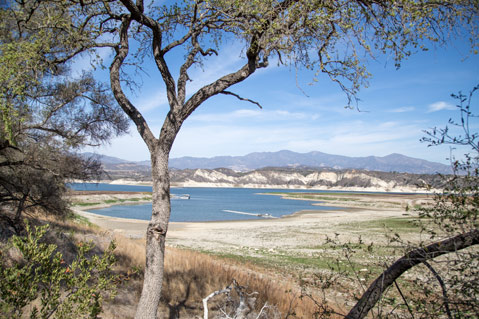Drought Gets Grimmer and Grimmer
Water Experts See Little Hope on the Horizon

Even if this winter’s much heralded El Niño delivers several rivers’ worth of rain, there was little hope expressed this week by a multitude of Santa Barbara water-district managers and water-board members that there would be any returning to the pre-drought days of indiscriminate lawn irrigation and car washing.
Setting the tone at the Association of California Water Agencies confab was ACWA chief and Sacramento lobbyist Tim Quinn, who stated, “We are living through a millennial drought. We’ve experienced the driest sequence of years in more than 1,000 years in California, and it’s hotter than it’s ever been.” Obviously, Quinn said, strong rains would help replenish groundwater basins, but he stressed, “We can’t assume El Niño will bail us out.”
The good news, he said, is that California water agencies have collectively spent $20 billion on infrastructure since the great drought beginning in 1987. Thanks to that investment, he said, California has absorbed the worst the current drought has to offer without sending the economy into a tailspin. The bad news is that more than 2,000 private wells in California’s Central Valley have gone dry, and more than 100 small water systems are now on the verge of collapse. Hydroelectric production statewide is down to the lowest levels since 1977, and more than half-a-million acres of agricultural fields have been fallowed. Eighteen species of fish, Quinn said, are threatened with extinction, water birds are struggling to make do without the flyway stopovers provided by rice farms, and the state’s coniferous forests are experiencing unprecedented die-offs.
After a sluggish start, California residents now are taking the drought seriously, cutting back consumption by 27 percent, 31 percent, and 27 percent, respectively, this June, July, and August. But the drop in sales volumes is taking a serious toll on the financial health of water districts, forcing managers to jack up rates and strip-mine their reserves. “People are getting pretty tired of this stuff,” Quinn said.
And living in the paradise of the South Coast offers little protection from the withering effects of the drought. Lake Cachuma — the single biggest water supply south of Santa Maria — is down to 16 percent of capacity. For the first time since the dam began operating in 1953, there will be absolutely zero water allocated from the reservoir this year. Even large groundwater basins — like Carpinteria’s — are slammed and need years of rest. Half the Santa Ynez Valley water district’s wells were recently shut down after the federal government adopted more stringent water-quality thresholds for chromium. The fix, it was announced, would cost $17.5 million.
The crucial subtext to the two-day event — the first was spent on an all-day tour of Lake Cachuma — was to bring water-district managers and boardmembers together to talk about common problems with the conspiratorial hope of fomenting a more regional response. As such, it functioned as a premature Thanksgiving dinner for a large, extended, and sometimes dysfunctional family.
ACWA, in this vein, provided the venue — at Buellton’s Marriott Hotel — and the turkey sandwiches. Pushing the gathering was Carpinteria Valley Water District General Manager Charles Hamilton and County Water Resources chief Tom Fayram. “We all operate out of our own silos looking out for our own interests,” explained Hamilton. “We need to get out of those silos.”

To that end, Hamilton and Fayram enlisted James Stubchaer, who for aeons reigned as Santa Barbara County’s unofficial “godfather” of all water engineers. Stubchaer delivered a quick yet comprehensive history of South Coast efforts to secure a reliable, sustainable supply of water, ending with the vote to import state water.
Whether Hamilton et al sparked the critical mass of collective good needed for regional cooperation or not, several very interesting factoids did emerge. For example, the county’s contract with the federal Bureau of Reclamation — which owns and operates the Lake Cachuma reservoir — expires in four years, but, it was quietly revealed, was finally paid off in full on September 25. For a reservoir with a capacity of 225,000 acre-feet of water, South Coast water agencies wound up spending a total of $43 million over the past six decades.
Currently, the dam is calibrated to operate on the expectation of seven-year drought cycles on par with the drought that started in 1947. The new reality hitting the hardest is the recognition that it may not be enough in the face of increasingly hot, dry weather patterns. To make it through the long haul of the new, more violent droughts, water customers may have to make do with 20,000 acre-feet a year, a significant cut from the 25,000 acre-feet the dam traditionally delivers annually. Also on the table will be heated discussions as to when water agencies must cut back use even farther once drought conditions are established. Had Cachuma’s member agencies agreed to cut back sooner — in accordance with a 1997 agreement — Fayram said Cachuma would have 20,000 acre-feet for distribution instead of nothing. Because there was no consensus among members, those cutbacks did not happen.
In contrast to Lake Cachuma’s price tag, the City of Santa Barbara is now spending $55 million just to rebuild its desalination plant. To double the anticipated capacity of that plant — necessary for the Montecito and Carpinteria water districts to avail themselves to that water — would cost another $20 million. While no decision has been made about such cooperative arrangements, the City of Santa Barbara will clearly be under considerable pressure to keep running the desalination plant — at a cost of about $5 million a year — even after the drought is over to compensate for anticipated losses from other key water sources.
Lastly, the cost to install all the pipes, pumps, and treatment facilities needed to hook the South Coast into the State Water Project — completed in 1997 — was $590 million. Although that system — which costs $50 million a year whether any water is provided or not — delivered only 5 percent of its contracted obligation last year, the system proved essential in moving water from Northern California rice farmers to Santa Barbara’s parched and desperate water agencies.
Many in attendance — and certainly ACWA’s Quinn — argued state government needs to remove regulatory obstacles making the marketing of water more difficult and expensive than it needs to be. State law allows, for example, water transfers but not outright sales. That means every acre-foot of northern California water “purchased” by South Coast agencies has to later be given back — often on a two-to-one basis — in addition to the money paid.



